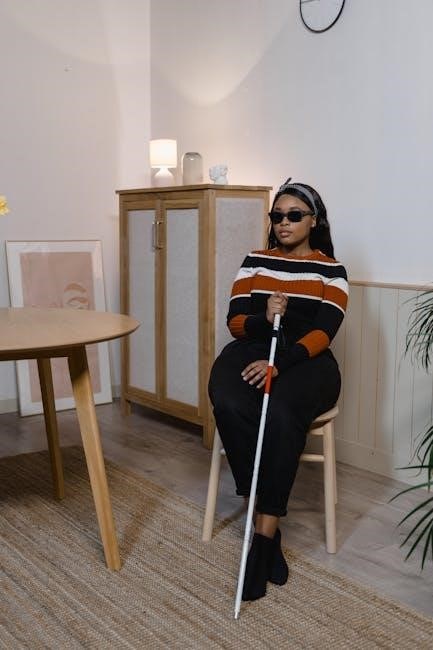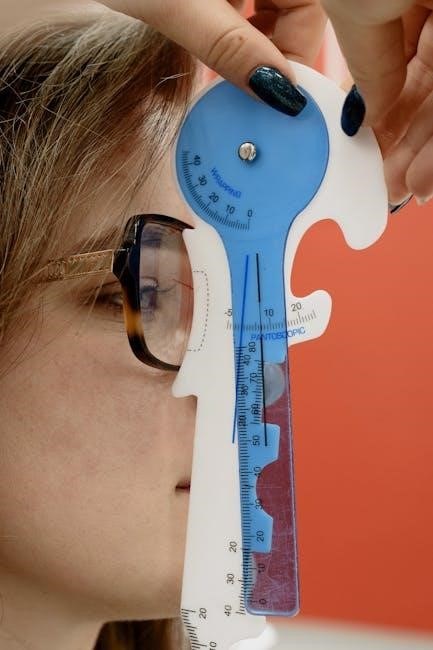This manual serves as a guide for evaluating vision impairment, focusing on tests, tools, and procedures to assess visual acuity and field. It emphasizes early detection and the role of specialists in ensuring accurate diagnoses and proper care for individuals with vision disabilities.
1.1 Importance of Regular Eye Tests
Regular eye tests are crucial for early detection of vision issues, preventing progression of impairments, and ensuring timely interventions. They help identify conditions affecting visual acuity and field, enabling personalized care plans. For individuals with disabilities, routine exams adapt to their needs, ensuring accessibility and accuracy in assessments. Early detection is key to maintaining vision health and quality of life.
1.2 Overview of Visual Acuity Tests
Visual acuity tests measure central vision clarity using tools like the Snellen chart. These assessments evaluate how well an individual can identify objects at a standard distance. Results determine vision impairment levels, guiding diagnoses and treatment plans. Regular testing ensures accurate monitoring of vision changes, crucial for early intervention and maintaining eye health effectively over time.

Understanding Visual Acuity
Visual acuity measures the sharpness of central vision, assessed using tools like the Snellen chart. It determines how clearly objects are seen at a standard distance, key for diagnosing vision impairments and guiding treatment plans.
2.1 What is Visual Acuity?
Visual acuity refers to the sharpness and clarity of vision, measuring the ability to identify objects or letters at a standard distance. It is quantified using fractions like 6/6 or 6/12, where the first number represents the distance in meters and the second indicates the size of objects seen. Lower acuity may signal impairment, requiring specialized assessments and care.
2.2 Snellen Chart and Its Role
The Snellen chart is a standardized tool used to measure visual acuity by displaying letters of decreasing sizes. It helps assess how well a person can see objects at a distance of 20 feet. The chart is essential in identifying vision impairments and is widely used in eye exams to determine if corrective measures are needed. Its role is crucial for accurate vision assessment and diagnosis.

Eye Tests for People with Disabilities
Eye tests for people with disabilities are tailored to address unique challenges, ensuring accurate vision assessment. They often involve specialized tools and techniques to accommodate individual needs effectively.
3.1 Challenges in Testing Individuals with Learning Disabilities

Testing individuals with learning disabilities presents unique challenges, including communication barriers and limited awareness of vision issues. Many may struggle to articulate symptoms or cooperate during exams. Specialized tools and techniques are often required to ensure accurate assessments. Portable equipment and adapted testing environments can help address these challenges, making the process more accessible and effective for individuals with diverse needs.
3.2 Specialized Tests for Visual Impairment
Specialized tests like the Snellen chart and visual field tests are crucial for assessing visual impairment. The Snellen test measures central vision, while visual field tests detect peripheral vision issues. Additionally, tools like the Functional Vision Assessment (FVA) help evaluate daily functioning. These tests ensure accurate diagnoses and tailored support for individuals with visual impairments, addressing their unique needs effectively.

Visual Field Tests
Visual field tests measure the width of an individual’s field of vision, detecting peripheral vision issues. They are crucial for diagnosing conditions like glaucoma and vision impairments, ensuring early detection and appropriate care. These non-invasive assessments provide detailed insights into a person’s visual capabilities, aiding in accurate diagnoses and tailored treatment plans for those with vision disabilities.
4.1 How Visual Field Tests Work
Visual field tests assess peripheral and central vision by detecting light sensitivity across the eye’s field. Patients respond to flashes of light in different locations, mapping their vision. Automated tools like the Humphrey Visual Field Analyzer or manual methods such as tangent screens are used. Results reveal blind spots or areas of reduced vision, aiding in diagnosing conditions like glaucoma or optic nerve damage. Testing is non-invasive and pain-free, providing critical insights for accurate diagnoses and treatment plans.
4.2 Importance in Diagnosing Vision Impairment
Visual field tests are crucial for detecting vision impairments, revealing blind spots, and assessing peripheral vision. They aid in diagnosing conditions like glaucoma, optic nerve damage, and retinal disorders. Early detection through these tests enables timely intervention, preventing further vision loss. Accurate mapping of vision loss is essential for determining eligibility for disability support and guiding personalized treatment plans, ensuring comprehensive eye care management.
Role of Optometrists and Ophthalmologists
Optometrists perform routine eye exams and visual acuity tests, while ophthalmologists handle complex diagnoses and surgeries. Both play key roles in detecting vision impairments and guiding care.
5.1 Who Performs the Tests?

Optometrists typically conduct routine eye exams, including visual acuity tests using tools like the Snellen chart. Ophthalmologists, however, perform more complex evaluations, such as visual field tests and low vision assessments. Both professionals collaborate to ensure accurate diagnoses and appropriate care, with specialists like ophthalmologists often involved in certifying vision impairment levels based on specific guidelines and measurements.
5.2 Differences Between Optometrists and Ophthalmologists
Optometrists primarily focus on routine eye care, prescribing glasses, and diagnosing common vision issues. Ophthalmologists, being medical doctors, handle surgeries, complex eye diseases, and advanced diagnostic procedures. While optometrists often perform initial vision assessments, ophthalmologists step in for specialized care, particularly in cases requiring surgical intervention or detailed examinations beyond standard visual acuity tests.

Low Vision Tests
Low vision tests are comprehensive, longer examinations focusing on maximizing usable vision. They are more thorough than regular eye exams, aiming to help individuals with significant vision loss.
6.1 What is a Low Vision Test?
A low vision test is a detailed, in-depth assessment to maximize usable vision for individuals with significant visual impairment. It evaluates central and peripheral vision, often requiring specialized tools. Unlike regular exams, it focuses on adapting to vision loss, ensuring personalized solutions to enhance daily functioning and independence, addressing specific challenges faced by those with severe vision limitations. This comprehensive approach ensures tailored care.
6.2 How It Differs from a Regular Eye Exam
A low vision test is more extensive and longer, typically taking 2-3 times more time than a regular eye exam. It focuses on maximizing remaining vision, using specialized tools and methods. Unlike standard exams, it emphasizes functional abilities and adaptability, providing tailored solutions to enhance daily activities. This comprehensive approach ensures personalized care for individuals with significant vision impairment, addressing unique challenges not covered in routine check-ups.

Assessing Vision in People with Learning Disabilities
Assessing vision in individuals with learning disabilities requires tailored approaches, ensuring accessibility and comfort. Tools like Functional Vision Assessment (FVA) help evaluate visual abilities, addressing unique needs effectively.
7.1 Special Considerations for Testing
Testing individuals with learning disabilities requires a supportive environment and clear communication. Challenges include limited verbal feedback and understanding of test instructions. Adaptive tools and techniques, such as simplified language and visual aids, are essential. A patient-centered approach ensures comfort and accuracy in assessing visual abilities. This helps in identifying specific needs and providing appropriate care.
7.2 Tools Like Functional Vision Assessment (FVA)
Functional Vision Assessment (FVA) is a practical tool for evaluating visual abilities in individuals with learning disabilities. It helps identify how they use vision in daily tasks, focusing on strengths and challenges. FVA is user-friendly, enabling carers and professionals to assess visual function effectively. This tool guides personalized support strategies, ensuring tailored interventions for improved independence and quality of life.
Disability Evaluation Criteria
Disability evaluation criteria focus on binocular visual acuity, measured using the Snellen chart, to determine vision impairment levels for certification purposes.
8.1 Measuring Binocular Visual Acuity
Binocular visual acuity measures the sharpness of central vision using both eyes together. It is assessed using the Snellen chart under standardized conditions. The results determine the level of vision impairment, with readings rounded up to the higher (worse) level if between two lines. This method provides a comprehensive assessment for disability evaluation, ensuring accurate vision impairment classification.
8.2 Guidelines for Determining Vision Impairment
Guidelines for determining vision impairment involve specific criteria to assess visual acuity and field. Both Snellen charts and visual field tests are utilized. Binocular visual acuity is prioritized as it reflects real-world vision. If measurements fall between two lines on the Snellen chart, they are rounded up to the higher level for accurate classification. These criteria ensure consistent and reliable evaluation, aiding specialists in proper vision impairment classification.
Certification Process
Certification involves evaluating visual acuity and field, with specialists assessing impairment levels. Eye specialists, like ophthalmologists, play a crucial role in determining eligibility for severe sight impairment certification.

9.1 How to Get Certified as Severely Sight Impaired
Certification as severely sight impaired involves a comprehensive eye examination by a specialist. They assess visual acuity and field to determine if it meets specific impairment criteria. Eligibility is based on binocular visual acuity, with measurements typically using the Snellen chart. A consultant ophthalmologist reviews the results to confirm the level of impairment and issues the certification.
9.2 Role of Eye Specialists in Certification
Eye specialists, such as consultant ophthalmologists, play a crucial role in certification. They conduct thorough examinations to assess visual acuity and field, ensuring accurate measurements. Specialists interpret test results, determine the severity of impairment, and provide official certification. Their expertise ensures that the evaluation process is reliable and adheres to established guidelines for vision impairment.

Challenges in Vision Impairment Assessment
Accessibility issues and lack of awareness about vision care often hinder accurate assessments, particularly for individuals with disabilities, making it crucial to address these barriers effectively.
10.1 Accessibility Issues
Accessibility issues often hinder vision impairment assessments, particularly for individuals with disabilities. Physical barriers, communication challenges, and lack of adapted tools can make eye exams difficult. Portable equipment and specialized training for optometrists can help address these challenges, ensuring exams are accessible and effective for all patients, including those with unique needs or disabilities.
10.2 Raising Awareness About Vision Care
Raising awareness about vision care is crucial to addressing vision impairment. Campaigns and educational resources emphasize the importance of regular eye tests, especially for vulnerable groups. Organizations like SeeAbility highlight the need for eye exams among people with disabilities. Increasing awareness helps reduce undiagnosed vision problems and promotes early intervention, ensuring better outcomes for individuals with visual impairments.
Tools and Equipment for Vision Assessment
Portable tools and advanced technology enhance vision testing flexibility. They enable comprehensive assessments of visual acuity and field, ensuring accurate evaluations for various vision impairments.
11.1 Portable Equipment for Flexible Assessments
Portable equipment offers versatility in vision testing, enabling assessments in various settings. Tools like handheld acuity charts and portable perimeters allow for flexible patient positioning, ensuring comfort and accessibility. This equipment is particularly beneficial for individuals with mobility challenges or disabilities, providing accurate results without the need for fixed setups. It enhances the convenience and reach of vision care services.
11.2 Use of Technology in Vision Testing
Technology enhances vision testing accuracy and accessibility. Digital chart systems and portable perimeters streamline assessments, while smartphone apps offer convenient vision screening. Automated tools reduce human error, ensuring reliable results. These innovations make eye exams more efficient and accessible, especially for individuals with disabilities, promoting earlier detection and better management of vision impairments.
This manual underscores the importance of regular eye tests and specialized assessments for vision impairment. By leveraging technology and expert care, individuals with disabilities can receive accurate diagnoses and tailored support. Early detection and accessible testing are crucial for improving quality of life. Raising awareness and promoting inclusive vision care ensures everyone can benefit from advancements in eye health management and disability support.